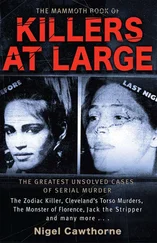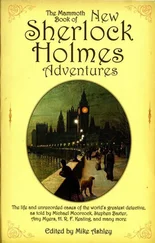I knew of Cesare Lombroso, of course. Was there a doctor in the world who didn’t?
“Just take a look at this one,” Holmes remarked, examining a portrait of a chap whom I had never heard of. “Observe the undulating brow, the infantile quiff of hair, the squashed potato of his nose, and that walrus of a moustache lounging on his upper lip. Lombroso would have classed him as a lowly confidence trickster, I have no doubt.”
I read a name beneath the portrait. “Arthur Conan Doyle, writer, it says here.”
“Never heard of him,” Holmes said as he moved on to the next one.
A man appeared very shortly and introduced himself to us as Mister John Joseph Elliott.
“I have a spare half-hour and can fit you in,” he said. “The receptionist came in, announced your names as Mister Holmes and Doctor Watson. When I turned back to the camera, my client had disappeared down the backstairs, taking my slideholder and a glass-plate negative with him.”
“What was he like, this man who stole his own shadow?” Holmes enquired.
Mister Elliott smiled. “It is a mechanical process,” he said. “Having seen so many individuals, I must admit, I have no memory for faces. Remember, too, that I see my sitters upside down through the lens of the camera.”
With no more a-do, we followed the photographist into the Portrait Parlour.
Holmes sat for far more pictures than I could have imagined, all of them in the “vignette” style, that is, showing only the head and the neck.
Mister Elliott had seemed disappointed when Holmes announced his purpose “head, no shoulders”, but he warmed to the task as the bearded potentate in the ridiculous pince-nez dictated precisely what he wanted. “Face front, eyes closed, eyes open. Left profile, chin up, chin down. The same sequence for the right profile. And, finally, the back of the head, which tells us more about a man than his dissembling face may wish to do.”
Seven photographs in all, and Mister Elliott retreated to the processing room with his bundle of glass negatives safe inside their slide-holders.
“We’ll need another set of seven,” said Holmes, as the photographist withdrew.
I imagined that he wanted to have my portrait taken, too, and I knew that Mary would be delighted. I was wandering around the large studio, examining a variety of painted backdrops. Here, we were in the country by a lake with swans; there, we were in a book-lined library with a writing desk, a clock and chair. Curtains and pillars seemed to play a large part in photography. Vases, too, a shelf of them in ascending order, small to large, together with a selection of banisters and balustrades of wood and plaster, which the artist could call upon as he felt fit. Then, suddenly, I heard a voice behind me.
“Where is he?”
The photographist was staring at Sherlock Holmes, who was sitting in the posing chair where previously the Grand Mufti of Jerusalem had been seated.
“To whom are you referring?” Holmes returned with a smile, indicating the fine raiments of his brother’s disguise, which he had deposited on a chaise-longue.
Mr Elliott looked from Holmes to the clothes, then back again.
“Come, come,” said Holmes, “an experiment, forgive me. Now, if you would just repeat the sequence of poses exactly as before, we will waste no more of your time.”
There were no plans for a photograph of me, though I managed to persuade Mister Elliott to take my likeness when Holmes had finished with him.
Ten minutes later, we left the studio, our enterprise complete. Holmes was now wearing only his knickerbocker suit, having donated Mycroft’s fancy dress to Mr Elliott, observing that the cloak, fez, beard and pince-nez would serve more useful purpose there than anywhere else in London.
The photographist promised to have the proofs delivered on Thursday to 221b Baker Street.
Thursday came, and Thursday went.
The photographs had been delivered in a package that morning, but Mycroft did not present himself as the Sheik of Araby, Chief Sitting Bull, or any of the other ethnic costume transformations that an indulgent minister would allow him.
It was Mrs Hudson’s half-day holiday, and Holmes was brewing tea on an enamelled Hungarian samovar, which some noble Magyar well-wisher had presented to him in remembrance of an investigation that had been successfully resolved.
“It is most unlike him,” Holmes remarked.
As the clock struck five, he reached for the telephone and made a call to Whitehall 1212.
“Have any corpulent corpses in foreign national costumes been found today?” he asked.
The duty sergeant reported that nothing of the sort had been reported, Mister ’olmes, then he passed the call on to another Whitehall number, which cannot be mentioned here in the interests of national security.
Mycroft was not in his office.
“There’s only one hope left,” said Holmes, as he dialled another number. “The Diogenes Club.”
The co-founder was, indeed, in his club, but another couple of minutes passed before he managed to reach the telephone in the hall from the billiards saloon.
“Mycroft,” Holmes pronounced in a tone of reprimand, “your tea is almost stewed.”
He listened for some moments, then said: “Very well, tomorrow, then.”
He dropped the telephone back on its hook. “He had forgotten entirely, if you ask me, though he made some lame excuse about rampaging Ethiopian privateers. Would you care to play mother, Watson?”
By which he meant would I serve the tea.
I served, of course, though I was certainly not in a motherly frame of mind. I had taken off the whole afternoon by the mean expedient of tacking a note to the surgery door, saying “ Called out to an emergency .” The majority of my private patients were valetudinarians, their health was not the true cause of their problems. What mattered more to me was the loss of the consultation fees, which would help me to pay for the nursery. Mary had told me just the day before: I was to be a father!
I had persuaded myself that I deserved a half-day holiday, just like Mrs Hudson. But I had been expecting to partake of a fascinating conversation regarding atavism, positivism, Lombroso and photography. The one thing missing was Mycroft Holmes.
“Just one cup of chà and one cigar,” Holmes announced, “then you and I will examine the contents of that package on the table by the window.”
“Our photographs?” I asked, as I handed him his cup, and watched with horror as he dropped five cubes of sugar into the queer-coloured liquid.
“The very same,” he said, his eyes lighting up with amusement as I sipped my tea, then coughed and spluttered.
“Do you call this tea ?” I said with disgust, and set my cup back on its saucer.
“It is called Woojeon,” Holmes said, labouring carefully over the pronunciation. “Hand-picked before the monsoons began last April, it is the finest first-flush green tea produced in the hills of North Korea. The natives call it chà , which differentiates it from the Chinese pronunciation of the same word, cha …”
“It really is rotten,” I protested. “Can’t we have a decent cup of Rosie Lee?”
“It is part of my latest experiment,” Holmes insisted. “I have been informed that there are four hundred and sixty-seven distinct varieties and blends of tea, and I intend to catalogue them all for forensic purposes. As you know, tea and tea leaves go together, but there are many other important characteristics that have never been adequately chronicled. How do the leaves dry at the bottom of an empty cup? What patterns do they form? How long does the distinctive aroma persist? Does the addition of one, two or more cubes of sugar alter the rate of desiccation? And so on,” he said with a wave of his long, bony fingers. “I feel pretty full, I must admit. I have been drinking tea all day.”
Читать дальше










